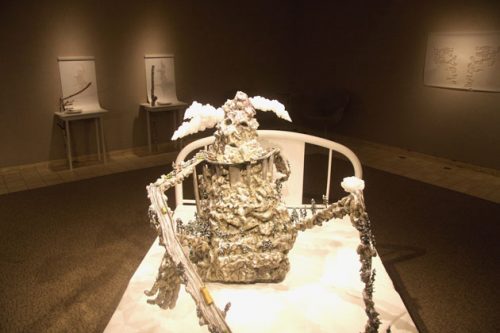Source: www.vueweekly.com
Author: Stephan Boissonneault
One of the most terrifying phrases known to our current human existence is “you have cancer.” Those three words can break a person.
“I would describe it as a terrible cyclone of information,” says head and neck cancer patient Kimberly Flowers. “You’re surrounded by all these medical teams, all these procedures and appointments, and you’re expected as [a] patient to make the best informed decisions while you’re in a state of emotional trauma. It’s just a whirlwind of confusion.”
With their project and exhibition See Me, Hear Me, Heal Me, clinicians, researchers, patients, and artists aim to recreate that initial confusion and the universal experience of head and neck cancer with multiple works of art.
“I thought art was the best way to express this because art presents an effective and visceral understanding to the experience,” head researcher of the project Dr. Minn Yoon says.
Yoon, being an assistant professor with the School of Dentistry at the University of Alberta, initially started the project by interviewing patients with head and neck cancer.
“My research has to do with the oral health of vulnerable populations, and patients with head and neck cancer fall into that category,” Yoon says. “I wanted to get a sense of what these people actually go through and how their lives change after learning they have head and neck cancer.”
After an interview with a patient who had undergone surgery to reconstruct her tongue, Yoon became aware that the project did not have to be confined to the realm of academia.
“Words alone were not sufficient,” Yoon says.
After meeting local artist Sean Caulfield, Yoon realized she had found the perfect medium to convey a new and authentic take on head and neck cancer—art.
Having done past work with biomedical art projects, Caulfield jumped on board. The project touched him not only on an artistic level, but also a very personal one.
“My mother had head and neck cancer so I had that personal experience,” Caulfield says.
His piece, “Veil,” is made up of nine wooden panels, each with its own unique image like a bouquet of flowers, lamps, and a suburban house. The images are clouded with sheets of printed disruption, blown up images of cancer cells that look as if they’re slowly consuming the entire piece.
“I started thinking about the memories of my mother and the classic hospital layout,” Caulfield says. “I thought about the ways this diagnoses creates a veil over the way you see your life.”
Similarly, Jill Ho-You’s piece, “Veils”, features hand cut mylar sheets of cancer MRI scans.
“I wanted to use a material that had the same ghostly presence as the MRI scans did,” Ho-You says. “I wanted to express the fragility of the human body. People don’t really ever think about their bodies when everything is fine, but when you get sick it becomes this weird alien experience.”
Like all of the artists featured in the exhibit, Caulfield and Ho-You’s goals were to create relatable imprints for head and neck cancer patients.
“It perfectly conveys what I experienced when I was told I had tongue cancer,” Flowers says. “Everything just seemed black to me and everything was so closed to me. I was existing at work and at home, but I was so numb to everything around me. You’re constantly grasping for the past.”
All of the pieces created in See Me, Hear Me, Heal Me were created after patients, artists, clinicians, and researchers all worked together to find the ubiquitous and invisible aspects of head and neck cancer.
“We had a workshop where we used something called imagery theatre where everyone involved, including the artists, got together and talked about head and neck cancer,” Yoon says.
“What really surprised me was that these artists were able to create something from someone else’s experience and brought a new accurate perspective,” Flowers adds.
Each piece in the exhibit stands out with its own literal spotlight.
There’s Jude Griebel’s “Obstructed” sculpture which features a patient on a hospital bed depicted as a grotesque anthropomorphic mountain that has just had a landslide. The piece chimes in on a person’s loss of identity when being diagnosed with head and neck cancer.
Another piece portraying that loss of identity is Brad Necyk’s “Waiting Room” which shows Flowers’ face digitally blurred out on a lit up background.
“My arm was used to repair my tongue and my leg skin was used to cover my arm,” Flowers says. “You come out quite fractured and your sense of self really changes.”
The exhibit does a superb job of expressing the hidden qualities of head and neck cancer.
“My experience has been very eye-opening, and through the exhibit I’ve had some enlightened moments with my own recovery with head and neck cancer,” Flowers says.
Yoon and the artists hope to soon unveil the exhibit internationally and use it as a means to promote the understanding of head and neck cancer.
“What has happened behind the scenes with these patients has been really moving to me as a researcher, but also as a human,” Yoon says. “I guess that shows the importance of fostering the humanistic qualities of academia, health, and art.”


Leave A Comment
You must be logged in to post a comment.